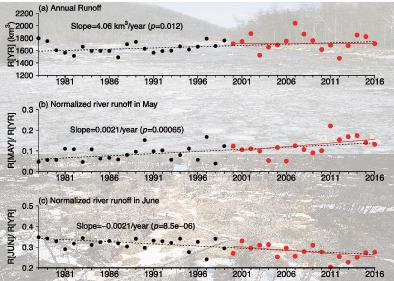当前位置:
X-MOL 学术
›
Hydrol. Process.
›
论文详情
Our official English website, www.x-mol.net, welcomes your
feedback! (Note: you will need to create a separate account there.)
Accelerated continental‐scale snowmelt and ecohydrological impacts in the four largest Siberian river basins in response to spring warming
Hydrological Processes ( IF 2.8 ) Pub Date : 2020-07-14 , DOI: 10.1002/hyp.13844 Kazuyoshi Suzuki 1 , Tetsuya Hiyama 2 , Koji Matsuo 3 , Kazuhito Ichii 4 , Yoshihiro Iijima 5 , Dai Yamazaki 6
Hydrological Processes ( IF 2.8 ) Pub Date : 2020-07-14 , DOI: 10.1002/hyp.13844 Kazuyoshi Suzuki 1 , Tetsuya Hiyama 2 , Koji Matsuo 3 , Kazuhito Ichii 4 , Yoshihiro Iijima 5 , Dai Yamazaki 6
Affiliation

|
River runoff from the four largest Siberian river basins (the Ob, Yenisei, Lena, and Kolyma) considerably contributes to freshwater flux into the Arctic Ocean from the Eurasian continent. However, the effects of variation in snow cover fraction on the ecohydrological variations in these basins are not well understood. In this study, we analysed the spatiotemporal variability of the maximum snow cover fraction (SCFmax) in the four Siberian river basins. We compared the SCFmax from 2000 to 2016 with data in terms of monthly temperature and precipitation, night‐time surface temperatures, the terrestrial water storage anomaly (TWSA), the normalised difference vegetation index (NDVI), and river runoff. Our results exhibit a decreasing trend in the April SCFmax values since 2000, largely in response to warming air temperatures in April. We identified snowmelt water as the dominant control on the observed increase in the runoff contribution in May across all four Siberian river basins. In addition, we detected that the interannual river runoff was predominantly controlled by interannual variations in the TWSA. The NDVI in June was strongly controlled by the timing of the snowmelt along with the surface air temperature and TWSA in June. The rate of increase in the freshwater flux from the four Siberian rivers decreased from 2000 to 2016, exhibiting large interannual variations corresponding to interannual variations in the TWSA. However, we identified a clear increase trend in the freshwater flux of ~4 km3/year when analysing the long‐term 39‐year historical record (1978–2016). Our results suggest that continued global warming will accelerate the transition towards the earlier timing of snowmelt and spring freshwater flux into the Arctic Ocean. Our findings also highlight the effects of earlier snowmelt on ecohydrological changes in the Northern Hemisphere.
中文翻译:

西伯利亚四大流域响应春季变暖,加速了大陆规模的融雪和生态水文影响
西伯利亚四个最大流域(鄂毕河,叶尼塞河,利纳河和科利马河)的径流大大促进了淡水从欧亚大陆流入北冰洋。但是,对于这些流域的积雪分数变化对生态水文变化的影响尚不清楚。在这项研究中,我们分析了四个西伯利亚流域的最大积雪分数(SCF max)的时空变化。我们将2000年至2016年的SCF最大值与月温度和降水量,夜间地表温度,陆地储水异常(TWSA),归一化差异植被指数(NDVI)和河流径流量等数据进行了比较。我们的结果显示4月份的SCF最大值呈下降趋势自2000年以来一直保持较高的值,主要是因为4月份气温上升。我们将融雪水确定为西伯利亚所有四个流域5月观测到的径流贡献增加的主要控制因素。此外,我们发现年际径流主要受TWSA的年际变化控制。6月的NDVI受融雪时间,6月地面气温和TWSA的强烈控制。西伯利亚四河的淡水通量增加速率从2000年到2016年下降,表现出较大的年际变化,与TWSA的年际变化相对应。但是,我们发现了〜4 km 3的淡水通量有明显的增加趋势。分析长期的39年历史记录(1978-2016年)时的数据/年。我们的结果表明,持续的全球变暖将加速向融雪和春季淡水通入北冰洋的更早时间过渡。我们的发现还强调了早期融雪对北半球生态水文学变化的影响。
更新日期:2020-07-14
中文翻译:

西伯利亚四大流域响应春季变暖,加速了大陆规模的融雪和生态水文影响
西伯利亚四个最大流域(鄂毕河,叶尼塞河,利纳河和科利马河)的径流大大促进了淡水从欧亚大陆流入北冰洋。但是,对于这些流域的积雪分数变化对生态水文变化的影响尚不清楚。在这项研究中,我们分析了四个西伯利亚流域的最大积雪分数(SCF max)的时空变化。我们将2000年至2016年的SCF最大值与月温度和降水量,夜间地表温度,陆地储水异常(TWSA),归一化差异植被指数(NDVI)和河流径流量等数据进行了比较。我们的结果显示4月份的SCF最大值呈下降趋势自2000年以来一直保持较高的值,主要是因为4月份气温上升。我们将融雪水确定为西伯利亚所有四个流域5月观测到的径流贡献增加的主要控制因素。此外,我们发现年际径流主要受TWSA的年际变化控制。6月的NDVI受融雪时间,6月地面气温和TWSA的强烈控制。西伯利亚四河的淡水通量增加速率从2000年到2016年下降,表现出较大的年际变化,与TWSA的年际变化相对应。但是,我们发现了〜4 km 3的淡水通量有明显的增加趋势。分析长期的39年历史记录(1978-2016年)时的数据/年。我们的结果表明,持续的全球变暖将加速向融雪和春季淡水通入北冰洋的更早时间过渡。我们的发现还强调了早期融雪对北半球生态水文学变化的影响。











































 京公网安备 11010802027423号
京公网安备 11010802027423号